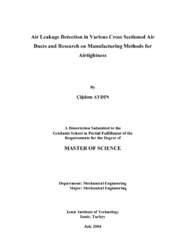Please use this identifier to cite or link to this item:
https://hdl.handle.net/11147/3313| Title: | Air Leakage Detection in Various Cross Sectioned Air Ducts and Research on Manufacturing Methods for Airtightness | Authors: | Aydın, Çiğdem | Advisors: | Özerdem, Mehmet Bariş | Publisher: | Izmir Institute of Technology Izmir Institute of Technology |
Abstract: | Air ducts and related equipments are important components of climate and ventilation systems in order to distribute clean air, necessary for the occupied space, to whole system and to control thermal comfort. Despite of Turkish standards on air duct are present, studies on energy consumption associated with air leakage are very rare in Turkey, on the contrary to many developed countries. In this study, the subject of preventing energy losses related to the leakage, which causes inefficient working condition, has been investigated. Firstly, air duct system and quality requirements have been explained and the main standards have been analyzed for airtightness of air distribution systems, as well. Secondly, duct system measurements have been conducted by choosing two different approaches. One approach covers leakage calculation of a single duct by using European Standard called Eurovent, whereas the other one divides the system into single sections and uses the Power Law Model for calculation of leakage occurred in each section.Single duct leakage measurements were made on 300 mm and 1000 mm diameter circular ducts and 300 mm by 250 mm and 1000 mm by 500 mm flanged joint rectangular ducts for positive internal pressures. Test results showed that duct leakage depends on the method of duct fabrication, method of sealing, workmanship and static pressure differential. Furthermore, calculated leakage factors were under the allowable leakage limits in classification .C. for rectangular and circular ducts that were produced by Venco A.Ş. Comparing rectangular to circular ducts both had the same length of seam and surface area; the leakage from circular ducts was less than 80% from rectangular ducts. The air leakage from all test ducts, with the same lock seam type, decreases, whereas the surface area increases.Branched duct leakage measurements were made on 300 mm and 630 mm diameter circular ducts and 300 mm by 200 mm and 500 mm by 300 mm rectangular ducts and also air distribution system for positive internal pressures. Test results showed that fittings in a system cause sudden changes in static pressure; therefore, duct leakage depends on fitting locations. The leakage rate in Spiro sealed system was less than 5% Trelleborg sealed system. The leakage measured in this study showed that seam leakage accounts from 14% to 20% of the total in the two rectangular ducts and from 8% to 13% for the round ducts with Pittsburgh and Spiral lock seams. These data show that the joints are the major source of duct leakage. Improvement in duct construction leading to duct systems with less leakage will need to focus on better joints. Keywords: airtightness duct system, air duct leakage, duct leakage model, ductwork test procedure and methods. | Description: | Thesis (Master)--Izmir Institute of Technology, Mechanical Engineering, Izmir, 2004 Includes bibliographical references (leaves: 65-67) Text in English; Abstract: Turkish and English xv,108 leaves |
URI: | http://hdl.handle.net/11147/3313 |
| Appears in Collections: | Master Degree / Yüksek Lisans Tezleri |
Files in This Item:
| File | Description | Size | Format | |
|---|---|---|---|---|
| T000515.pdf | MasterThesis | 25.39 MB | Adobe PDF |  View/Open |
CORE Recommender
Items in GCRIS Repository are protected by copyright, with all rights reserved, unless otherwise indicated.